2007 CHEVROLET HHR coolant temperature
[x] Cancel search: coolant temperaturePage 309 of 446
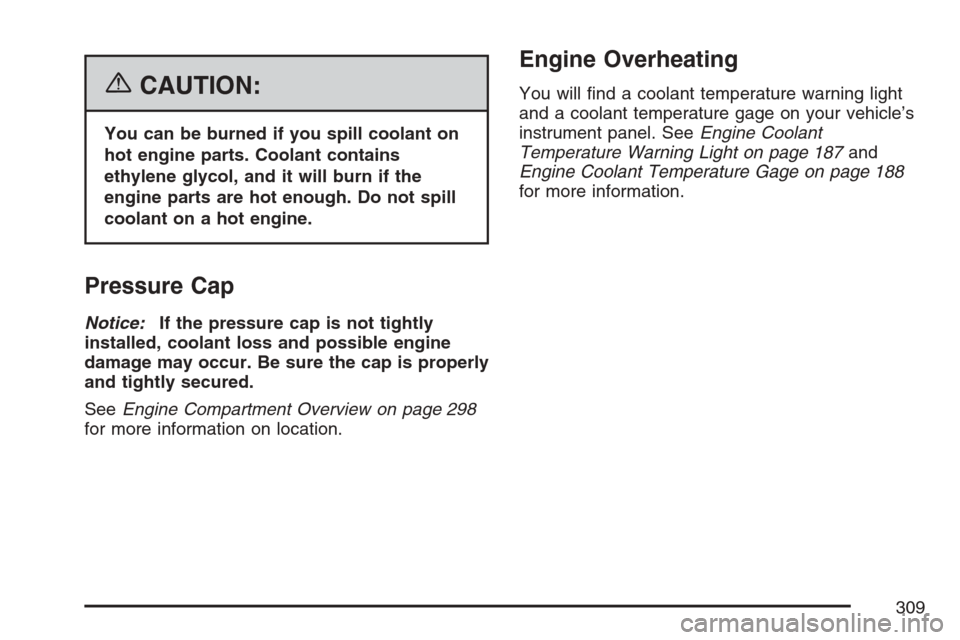
{CAUTION:
You can be burned if you spill coolant on
hot engine parts. Coolant contains
ethylene glycol, and it will burn if the
engine parts are hot enough. Do not spill
coolant on a hot engine.
Pressure Cap
Notice:If the pressure cap is not tightly
installed, coolant loss and possible engine
damage may occur. Be sure the cap is properly
and tightly secured.
SeeEngine Compartment Overview on page 298
for more information on location.
Engine Overheating
You will �nd a coolant temperature warning light
and a coolant temperature gage on your vehicle’s
instrument panel. SeeEngine Coolant
Temperature Warning Light on page 187and
Engine Coolant Temperature Gage on page 188
for more information.
309
Page 310 of 446
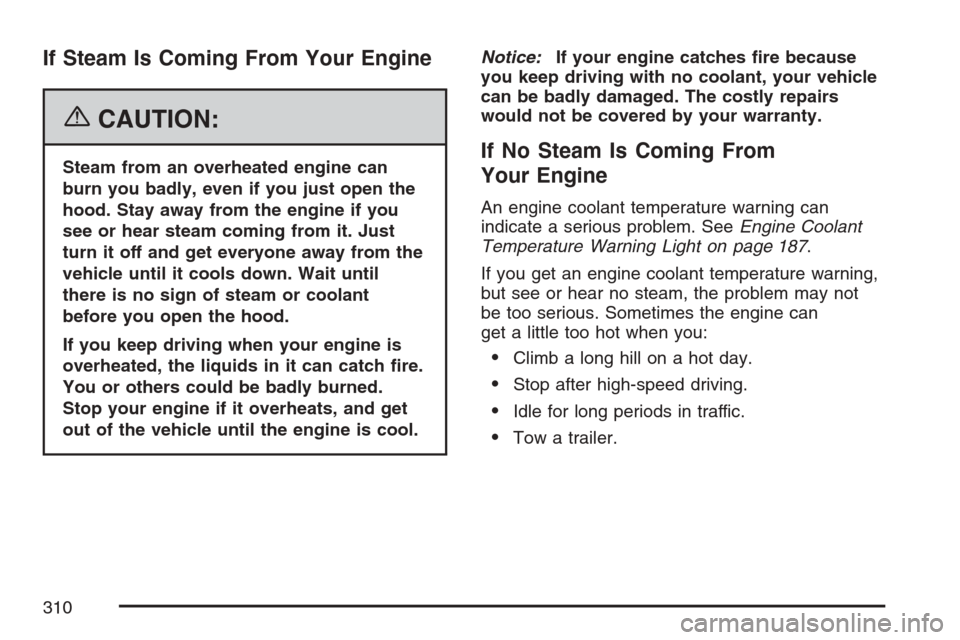
If Steam Is Coming From Your Engine
{CAUTION:
Steam from an overheated engine can
burn you badly, even if you just open the
hood. Stay away from the engine if you
see or hear steam coming from it. Just
turn it off and get everyone away from the
vehicle until it cools down. Wait until
there is no sign of steam or coolant
before you open the hood.
If you keep driving when your engine is
overheated, the liquids in it can catch �re.
You or others could be badly burned.
Stop your engine if it overheats, and get
out of the vehicle until the engine is cool.Notice:If your engine catches �re because
you keep driving with no coolant, your vehicle
can be badly damaged. The costly repairs
would not be covered by your warranty.If No Steam Is Coming From
Your Engine
An engine coolant temperature warning can
indicate a serious problem. SeeEngine Coolant
Temperature Warning Light on page 187.
If you get an engine coolant temperature warning,
but see or hear no steam, the problem may not
be too serious. Sometimes the engine can
get a little too hot when you:
Climb a long hill on a hot day.
Stop after high-speed driving.
Idle for long periods in traffic.
Tow a trailer.
310
Page 311 of 446
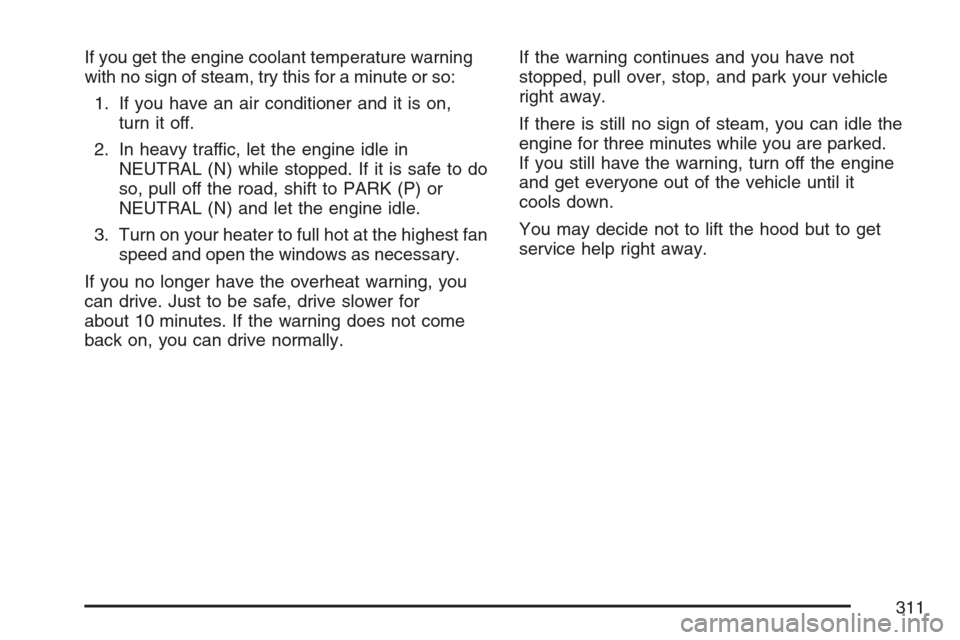
If you get the engine coolant temperature warning
with no sign of steam, try this for a minute or so:
1. If you have an air conditioner and it is on,
turn it off.
2. In heavy traffic, let the engine idle in
NEUTRAL (N) while stopped. If it is safe to do
so, pull off the road, shift to PARK (P) or
NEUTRAL (N) and let the engine idle.
3. Turn on your heater to full hot at the highest fan
speed and open the windows as necessary.
If you no longer have the overheat warning, you
can drive. Just to be safe, drive slower for
about 10 minutes. If the warning does not come
back on, you can drive normally.If the warning continues and you have not
stopped, pull over, stop, and park your vehicle
right away.
If there is still no sign of steam, you can idle the
engine for three minutes while you are parked.
If you still have the warning, turn off the engine
and get everyone out of the vehicle until it
cools down.
You may decide not to lift the hood but to get
service help right away.
311
Page 316 of 446
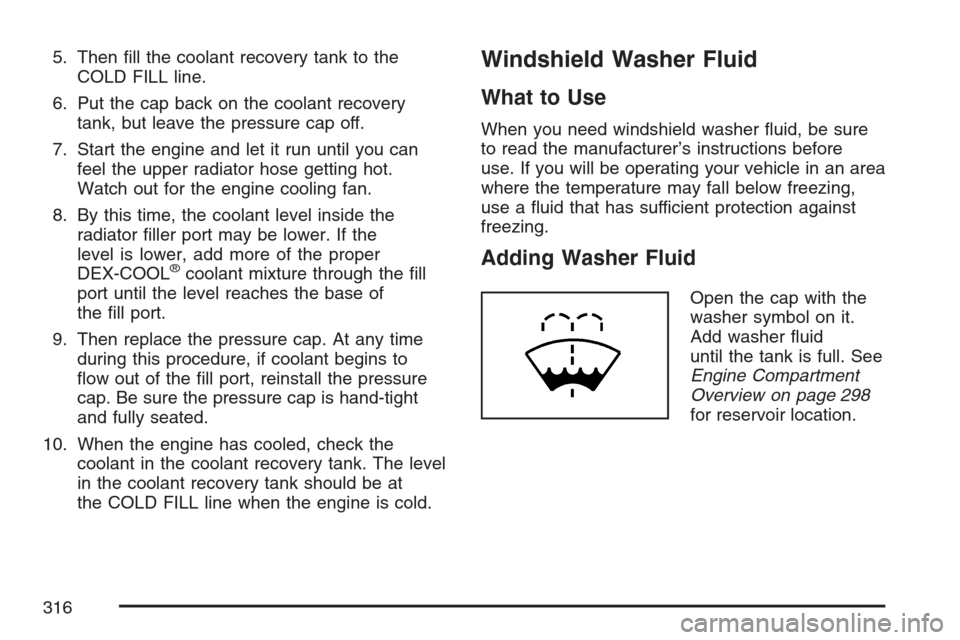
5. Then �ll the coolant recovery tank to the
COLD FILL line.
6. Put the cap back on the coolant recovery
tank, but leave the pressure cap off.
7. Start the engine and let it run until you can
feel the upper radiator hose getting hot.
Watch out for the engine cooling fan.
8. By this time, the coolant level inside the
radiator �ller port may be lower. If the
level is lower, add more of the proper
DEX-COOL
®coolant mixture through the �ll
port until the level reaches the base of
the �ll port.
9. Then replace the pressure cap. At any time
during this procedure, if coolant begins to
�ow out of the �ll port, reinstall the pressure
cap. Be sure the pressure cap is hand-tight
and fully seated.
10. When the engine has cooled, check the
coolant in the coolant recovery tank. The level
in the coolant recovery tank should be at
the COLD FILL line when the engine is cold.
Windshield Washer Fluid
What to Use
When you need windshield washer �uid, be sure
to read the manufacturer’s instructions before
use. If you will be operating your vehicle in an area
where the temperature may fall below freezing,
use a �uid that has sufficient protection against
freezing.
Adding Washer Fluid
Open the cap with the
washer symbol on it.
Add washer �uid
until the tank is full. See
Engine Compartment
Overview on page 298
for reservoir location.
316
Page 398 of 446
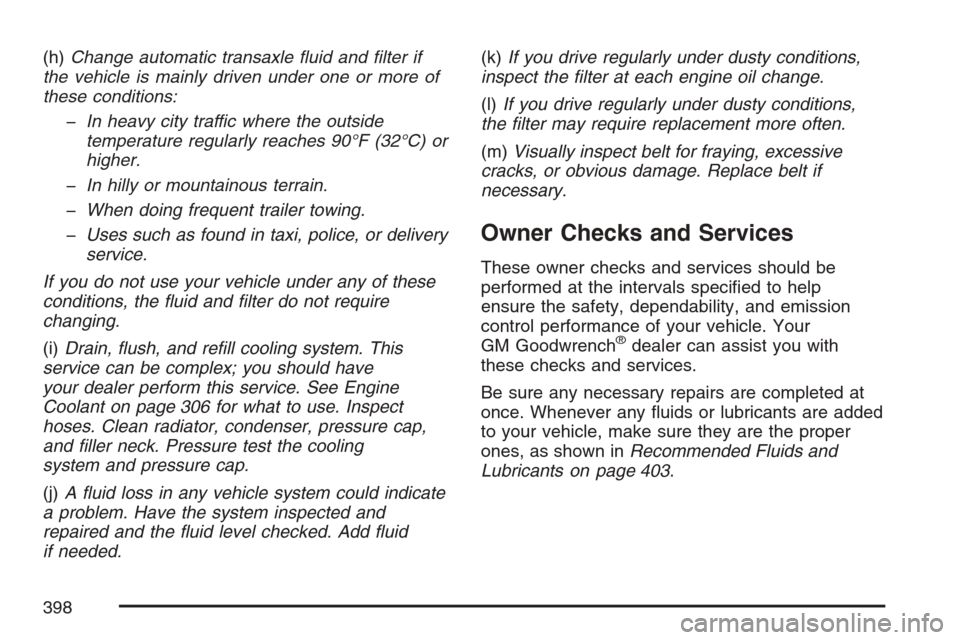
(h)Change automatic transaxle fluid and filter if
the vehicle is mainly driven under one or more of
these conditions:
�In heavy city traffic where the outside
temperature regularly reaches 90°F (32°C) or
higher.
�In hilly or mountainous terrain.
�When doing frequent trailer towing.
�Uses such as found in taxi, police, or delivery
service.
If you do not use your vehicle under any of these
conditions, the fluid and filter do not require
changing.
(i)Drain, flush, and refill cooling system. This
service can be complex; you should have
your dealer perform this service. See Engine
Coolant on page 306 for what to use. Inspect
hoses. Clean radiator, condenser, pressure cap,
and filler neck. Pressure test the cooling
system and pressure cap.
(j)A fluid loss in any vehicle system could indicate
a problem. Have the system inspected and
repaired and the fluid level checked. Add fluid
if needed.(k)If you drive regularly under dusty conditions,
inspect the filter at each engine oil change.
(l)If you drive regularly under dusty conditions,
the filter may require replacement more often.
(m)Visually inspect belt for fraying, excessive
cracks, or obvious damage. Replace belt if
necessary.
Owner Checks and Services
These owner checks and services should be
performed at the intervals speci�ed to help
ensure the safety, dependability, and emission
control performance of your vehicle. Your
GM Goodwrench
®dealer can assist you with
these checks and services.
Be sure any necessary repairs are completed at
once. Whenever any �uids or lubricants are added
to your vehicle, make sure they are the proper
ones, as shown inRecommended Fluids and
Lubricants on page 403.
398
Page 435 of 446
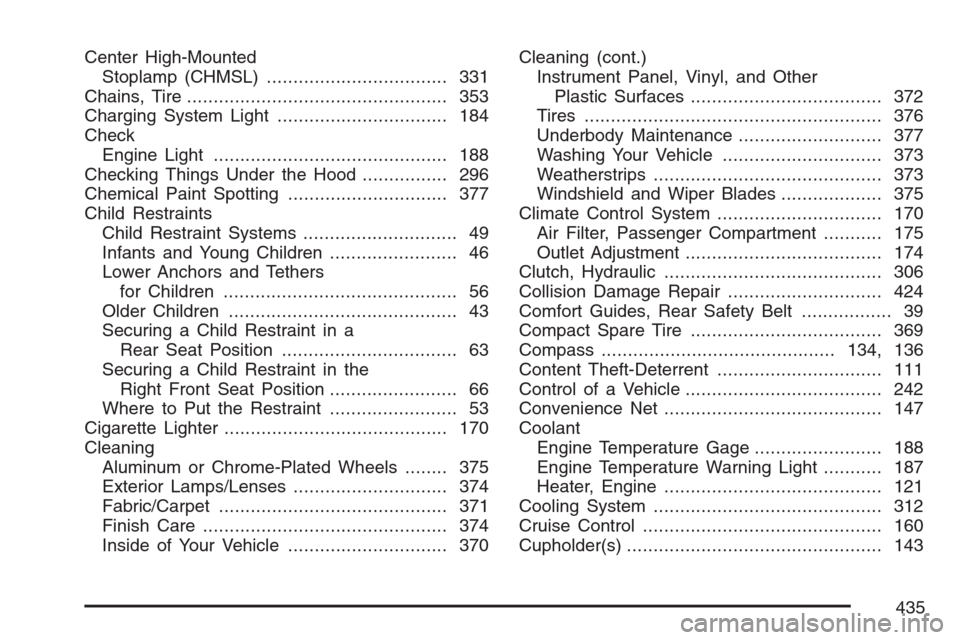
Center High-Mounted
Stoplamp (CHMSL).................................. 331
Chains, Tire................................................. 353
Charging System Light................................ 184
Check
Engine Light............................................ 188
Checking Things Under the Hood................ 296
Chemical Paint Spotting.............................. 377
Child Restraints
Child Restraint Systems............................. 49
Infants and Young Children........................ 46
Lower Anchors and Tethers
for Children............................................ 56
Older Children........................................... 43
Securing a Child Restraint in a
Rear Seat Position................................. 63
Securing a Child Restraint in the
Right Front Seat Position........................ 66
Where to Put the Restraint........................ 53
Cigarette Lighter.......................................... 170
Cleaning
Aluminum or Chrome-Plated Wheels........ 375
Exterior Lamps/Lenses............................. 374
Fabric/Carpet........................................... 371
Finish Care.............................................. 374
Inside of Your Vehicle.............................. 370Cleaning (cont.)
Instrument Panel, Vinyl, and Other
Plastic Surfaces.................................... 372
Tires........................................................ 376
Underbody Maintenance........................... 377
Washing Your Vehicle .............................. 373
Weatherstrips........................................... 373
Windshield and Wiper Blades................... 375
Climate Control System............................... 170
Air Filter, Passenger Compartment........... 175
Outlet Adjustment..................................... 174
Clutch, Hydraulic......................................... 306
Collision Damage Repair............................. 424
Comfort Guides, Rear Safety Belt................. 39
Compact Spare Tire.................................... 369
Compass............................................134, 136
Content Theft-Deterrent............................... 111
Control of a Vehicle..................................... 242
Convenience Net......................................... 147
Coolant
Engine Temperature Gage........................ 188
Engine Temperature Warning Light........... 187
Heater, Engine......................................... 121
Cooling System........................................... 312
Cruise Control............................................. 160
Cupholder(s)................................................ 143
435
Page 437 of 446
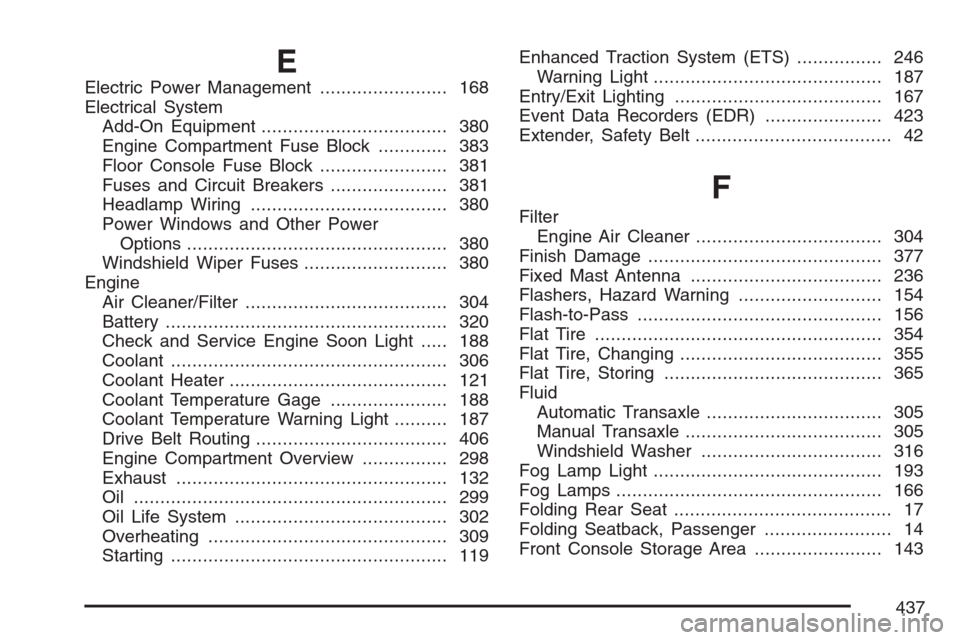
E
Electric Power Management........................ 168
Electrical System
Add-On Equipment................................... 380
Engine Compartment Fuse Block............. 383
Floor Console Fuse Block........................ 381
Fuses and Circuit Breakers...................... 381
Headlamp Wiring..................................... 380
Power Windows and Other Power
Options................................................. 380
Windshield Wiper Fuses........................... 380
Engine
Air Cleaner/Filter...................................... 304
Battery..................................................... 320
Check and Service Engine Soon Light..... 188
Coolant.................................................... 306
Coolant Heater......................................... 121
Coolant Temperature Gage...................... 188
Coolant Temperature Warning Light.......... 187
Drive Belt Routing.................................... 406
Engine Compartment Overview................ 298
Exhaust................................................... 132
Oil ........................................................... 299
Oil Life System........................................ 302
Overheating............................................. 309
Starting.................................................... 119Enhanced Traction System (ETS) ................ 246
Warning Light........................................... 187
Entry/Exit Lighting....................................... 167
Event Data Recorders (EDR)...................... 423
Extender, Safety Belt..................................... 42
F
Filter
Engine Air Cleaner................................... 304
Finish Damage............................................ 377
Fixed Mast Antenna.................................... 236
Flashers, Hazard Warning........................... 154
Flash-to-Pass.............................................. 156
Flat Tire...................................................... 354
Flat Tire, Changing...................................... 355
Flat Tire, Storing......................................... 365
Fluid
Automatic Transaxle................................. 305
Manual Transaxle..................................... 305
Windshield Washer.................................. 316
Fog Lamp Light........................................... 193
Fog Lamps.................................................. 166
Folding Rear Seat......................................... 17
Folding Seatback, Passenger........................ 14
Front Console Storage Area........................ 143
437
Page 438 of 446
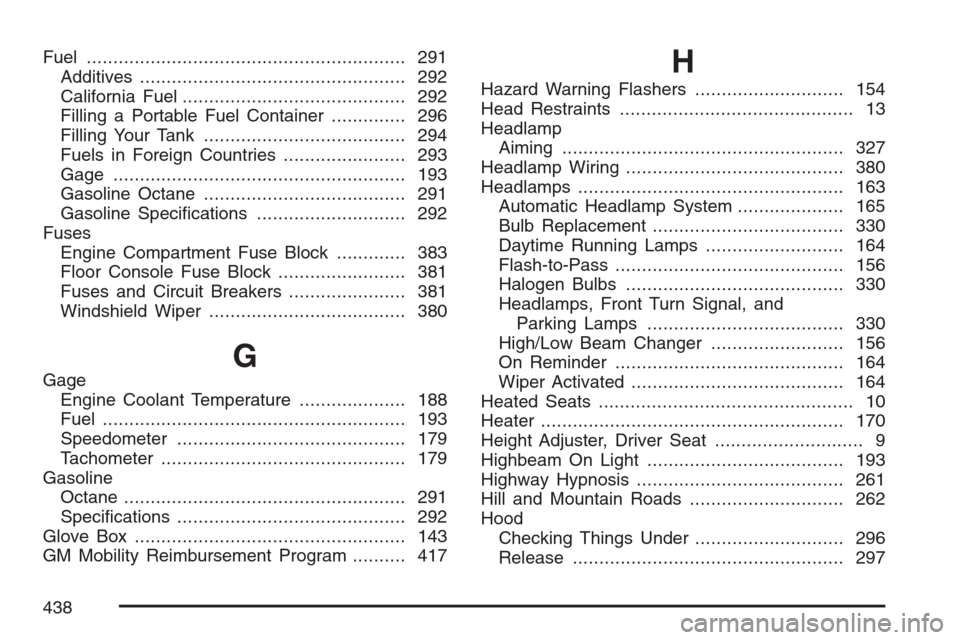
Fuel............................................................ 291
Additives.................................................. 292
California Fuel.......................................... 292
Filling a Portable Fuel Container.............. 296
Filling Your Tank...................................... 294
Fuels in Foreign Countries....................... 293
Gage....................................................... 193
Gasoline Octane...................................... 291
Gasoline Speci�cations............................ 292
Fuses
Engine Compartment Fuse Block............. 383
Floor Console Fuse Block........................ 381
Fuses and Circuit Breakers...................... 381
Windshield Wiper..................................... 380
G
Gage
Engine Coolant Temperature.................... 188
Fuel......................................................... 193
Speedometer........................................... 179
Tachometer.............................................. 179
Gasoline
Octane..................................................... 291
Speci�cations........................................... 292
Glove Box................................................... 143
GM Mobility Reimbursement Program.......... 417
H
Hazard Warning Flashers............................ 154
Head Restraints............................................ 13
Headlamp
Aiming..................................................... 327
Headlamp Wiring......................................... 380
Headlamps.................................................. 163
Automatic Headlamp System.................... 165
Bulb Replacement.................................... 330
Daytime Running Lamps.......................... 164
Flash-to-Pass........................................... 156
Halogen Bulbs......................................... 330
Headlamps, Front Turn Signal, and
Parking Lamps..................................... 330
High/Low Beam Changer ......................... 156
On Reminder........................................... 164
Wiper Activated........................................ 164
Heated Seats................................................ 10
Heater......................................................... 170
Height Adjuster, Driver Seat............................ 9
Highbeam On Light..................................... 193
Highway Hypnosis....................................... 261
Hill and Mountain Roads............................. 262
Hood
Checking Things Under............................ 296
Release................................................... 297
438